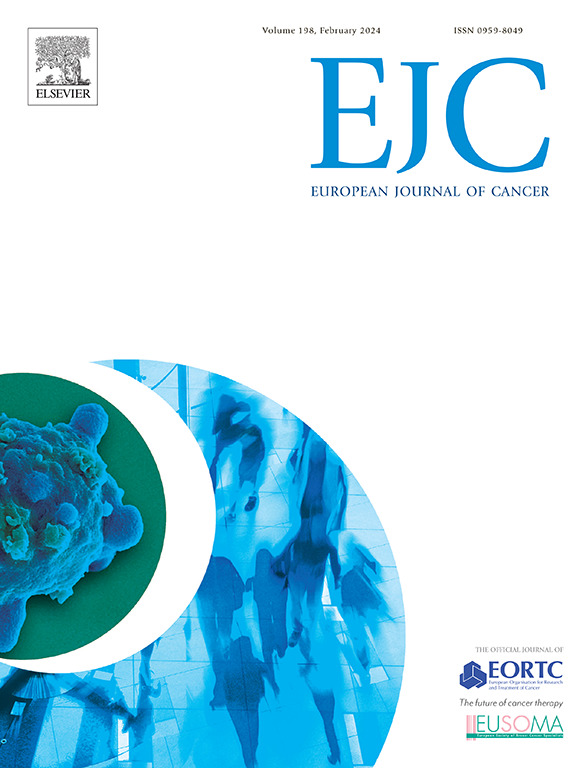First-line checkpoint inhibitor therapy in metastatic acral lentiginous melanoma compared to other types of cutaneous melanoma: A multicenter study from the prospective skin cancer registry ADOREG
IF 7.6
1区 医学
Q1 ONCOLOGY
引用次数: 0
Abstract
Background
Melanoma is the main cause of skin cancer-related death. Treatment with immune checkpoint inhibitors (CPI) has improved the prognosis in recent years. However, subtypes of melanoma differ in their response. Acral lentiginous melanoma (ALM) has a worse prognosis compared to cutaneous melanoma other than ALM (CM) and is therefore of particular relevance.
Aims
To evaluate the efficacy of CPI in first-line treatment of patients with advanced ALM compared CM.
Methods
Retrospective analysis of patients with metastatic ALM (n = 45) or CM (n = 328) who received first-line CPI therapy from the multicenter prospective skin cancer registry ADOREG. Study endpoints were best overall response (BOR), progression-free survival (PFS) and overall survival (OS).
Results
ALM patients had significantly higher rates of ulcerated tumors, loco regional metastases and fewer BRAF-mutated tumors compared to CM patients. Combined CPI was administered in 48.9 % ALM patients and 39.3 % of CM patients, while the remaining patients received PD-1 monotherapy. OS trended to be shorter in patients with ALM (18.1 vs. 43.8 months, p = 0.10) with no significant differences in PFS (7.0 vs. 11.5 months, p = 0.21). In patients with CM, median OS with combined CPI was not reached, whereas the median OS after PD-1 monotherapy was 37.8 months (p = 0.22). Conversely, in patients with ALM, OS with combined CPI was 17.8 months, compared to 26 months with PD-1 monotherapy (p = 0.15). There were no significant differences in BOR between patients with ALM or CM.
Conclusion
Analysis of this real-world cohort of patients with metastatic melanoma showed a trend towards poorer survival outcomes upon first-line treatment with CPI in ALM compared to cutaneous melanoma of other subtypes.
与其他类型的皮肤黑色素瘤相比,一线检查点抑制剂治疗转移性肢端小透镜性黑色素瘤:一项来自前瞻性皮肤癌登记处ADOREG的多中心研究
黑色素瘤是皮肤癌相关死亡的主要原因。近年来,免疫检查点抑制剂(CPI)治疗改善了预后。然而,黑色素瘤亚型的反应不同。肢端黄斑性黑色素瘤(ALM)与除ALM (CM)外的皮肤黑色素瘤相比预后更差,因此具有特殊的相关性。目的评价CPI与CM在晚期ALM一线治疗中的疗效。方法回顾性分析多中心前瞻性皮肤癌登记处ADOREG中接受一线CPI治疗的转移性ALM (n = 45)或CM (n = 328)患者。研究终点为最佳总缓解(BOR)、无进展生存期(PFS)和总生存期(OS)。结果与CM患者相比,salm患者的肿瘤溃疡率、局部区域转移率和braf突变肿瘤发生率均显著高于CM患者。48.9% %的ALM患者和39.3% %的CM患者接受联合CPI治疗,其余患者接受PD-1单药治疗。ALM患者的OS更短(18.1个月vs. 43.8个月,p = 0.10),PFS无显著差异(7.0个月vs. 11.5个月,p = 0.21)。在CM患者中,联合CPI的中位OS未达到,而PD-1单药治疗后的中位OS为37.8个月(p = 0.22)。相反,在ALM患者中,联合CPI的OS为17.8个月,而PD-1单药治疗的OS为26个月(p = 0.15)。ALM和CM患者的BOR无显著差异。结论:对现实世界中转移性黑色素瘤患者队列的分析显示,与其他亚型皮肤黑色素瘤相比,ALM患者在接受CPI一线治疗后的生存结果更差。
本文章由计算机程序翻译,如有差异,请以英文原文为准。
求助全文
约1分钟内获得全文
求助全文
来源期刊

European Journal of Cancer
医学-肿瘤学
CiteScore
11.50
自引率
4.80%
发文量
953
审稿时长
23 days
期刊介绍:
The European Journal of Cancer (EJC) serves as a comprehensive platform integrating preclinical, digital, translational, and clinical research across the spectrum of cancer. From epidemiology, carcinogenesis, and biology to groundbreaking innovations in cancer treatment and patient care, the journal covers a wide array of topics. We publish original research, reviews, previews, editorial comments, and correspondence, fostering dialogue and advancement in the fight against cancer. Join us in our mission to drive progress and improve outcomes in cancer research and patient care.
 求助内容:
求助内容: 应助结果提醒方式:
应助结果提醒方式:


